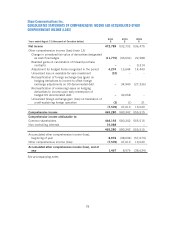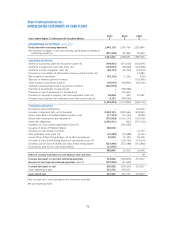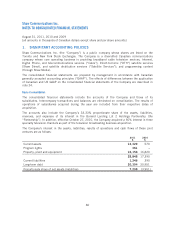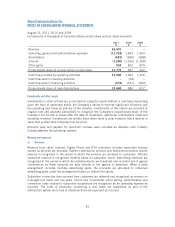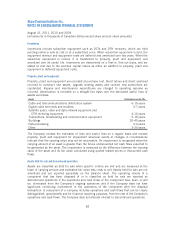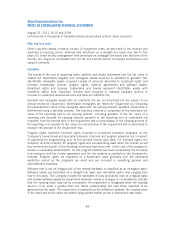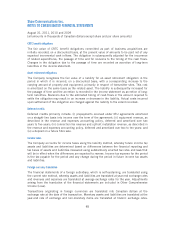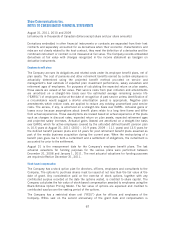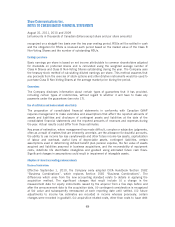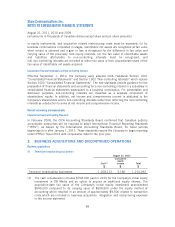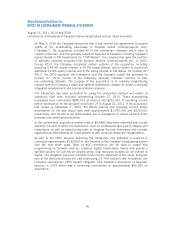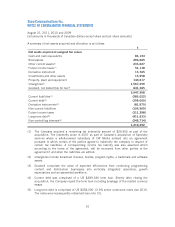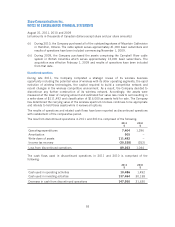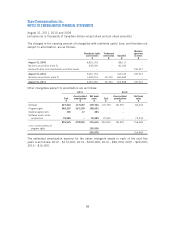Shaw 2011 Annual Report Download - page 92
Download and view the complete annual report
Please find page 92 of the 2011 Shaw annual report below. You can navigate through the pages in the report by either clicking on the pages listed below, or by using the keyword search tool below to find specific information within the annual report.Shaw Communications Inc.
NOTES TO CONSOLIDATED FINANCIAL STATEMENTS
August 31, 2011, 2010 and 2009
[all amounts in thousands of Canadian dollars except share and per share amounts]
recognized on a straight-line basis over the two year vesting period. RSUs will be settled in cash
and the obligation for RSUs is revalued each period based on the market value of the Class B
Non-Voting Shares and the number of outstanding RSUs.
Earnings per share
Basic earnings per share is based on net income attributable to common shareholders adjusted
for dividends on preferred shares and is calculated using the weighted average number of
Class A Shares and Class B Non-Voting Shares outstanding during the year. The Company uses
the treasury stock method of calculating diluted earnings per share. This method assumes that
any proceeds from the exercise of stock options and other dilutive instruments would be used to
purchase Class B Non-Voting Shares at the average market price during the period.
Guarantees
The Company discloses information about certain types of guarantees that it has provided,
including certain types of indemnities, without regard to whether it will have to make any
payments under the guarantees (see note 17).
Use of estimates and measurement uncertainty
The preparation of consolidated financial statements in conformity with Canadian GAAP
requires management to make estimates and assumptions that affect the reported amounts of
assets and liabilities and disclosure of contingent assets and liabilities at the date of the
consolidated financial statements and the reported amounts of revenues and expenses during
the year. Actual results could differ from those estimates.
Key areas of estimation, where management has made difficult, complex or subjective judgments,
often as a result of matters that are inherently uncertain, are the allowance for doubtful accounts,
the ability to use income tax loss carryforwards and other future income tax assets, capitalization
of labour and overhead, useful lives of depreciable assets, contingent liabilities, certain
assumptions used in determining defined benefit plan pension expense, the fair value of assets
acquired and liabilities assumed in business acquisitions, and the recoverability of equipment
costs, indefinite life identifiable intangibles and goodwill using estimated future cash flows.
Significant changes in assumptions could result in impairment of intangible assets.
Adoption of recent accounting pronouncements
Business Combinations
Effective September 1, 2010, the Company early adopted CICA Handbook Section 1582
“Business Combinations”, which replaces Section 1581 “Business Combinations”. The
differences which arise from the new accounting standard relate to details in applying the
acquisition method. The significant changes that result include (i) a change in the
measurement date for equity instruments issued by the acquirer from a few days before and
after the announcement date to the acquisition date, (ii) contingent consideration is recognized
at fair value and subsequently remeasured at each reporting date until settled, (iii) future
adjustments to income tax estimates are recorded in income whereas previously, certain
changes were recorded in goodwill, (iv) acquisition related costs, other than costs to issue debt
88


